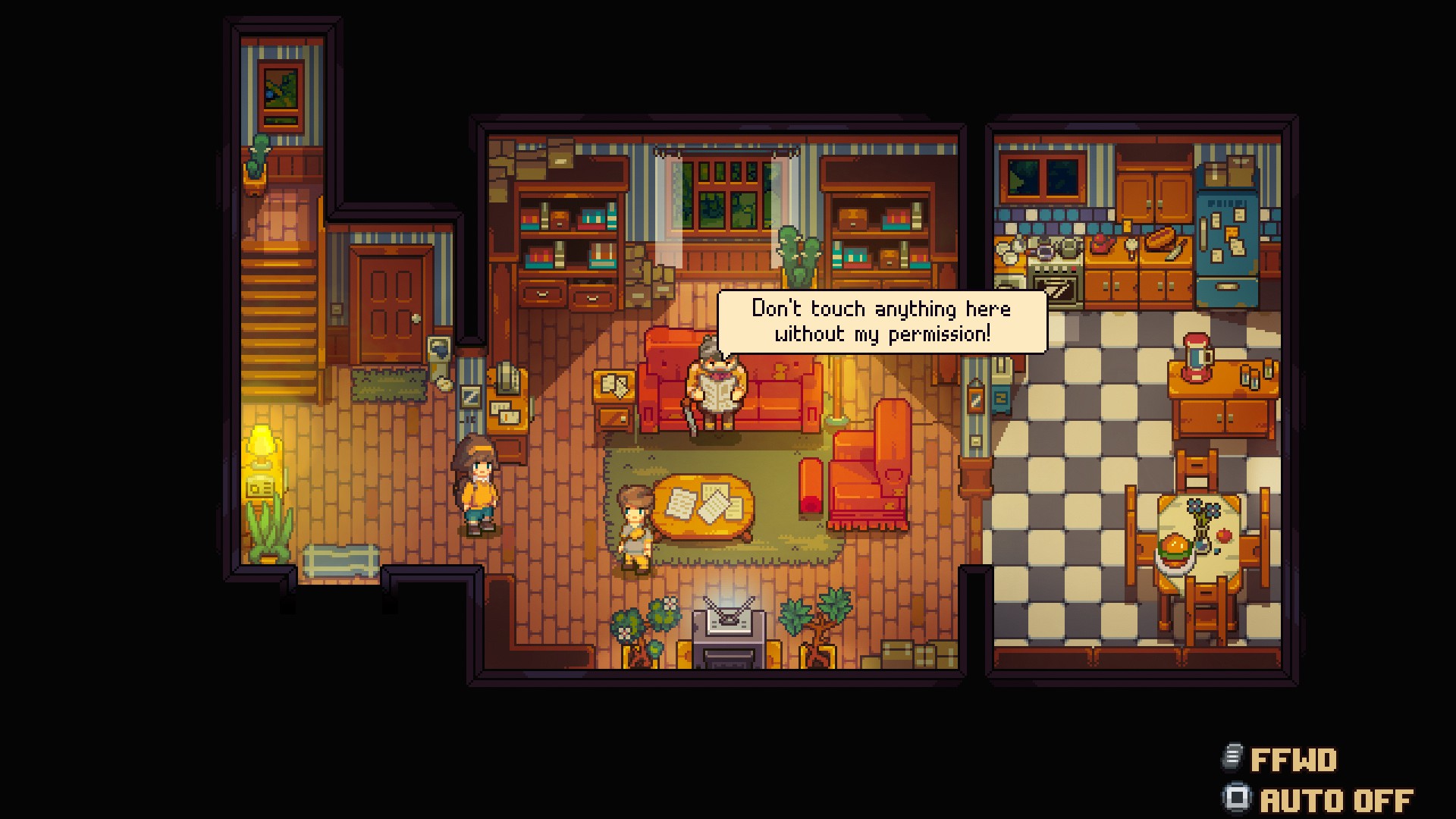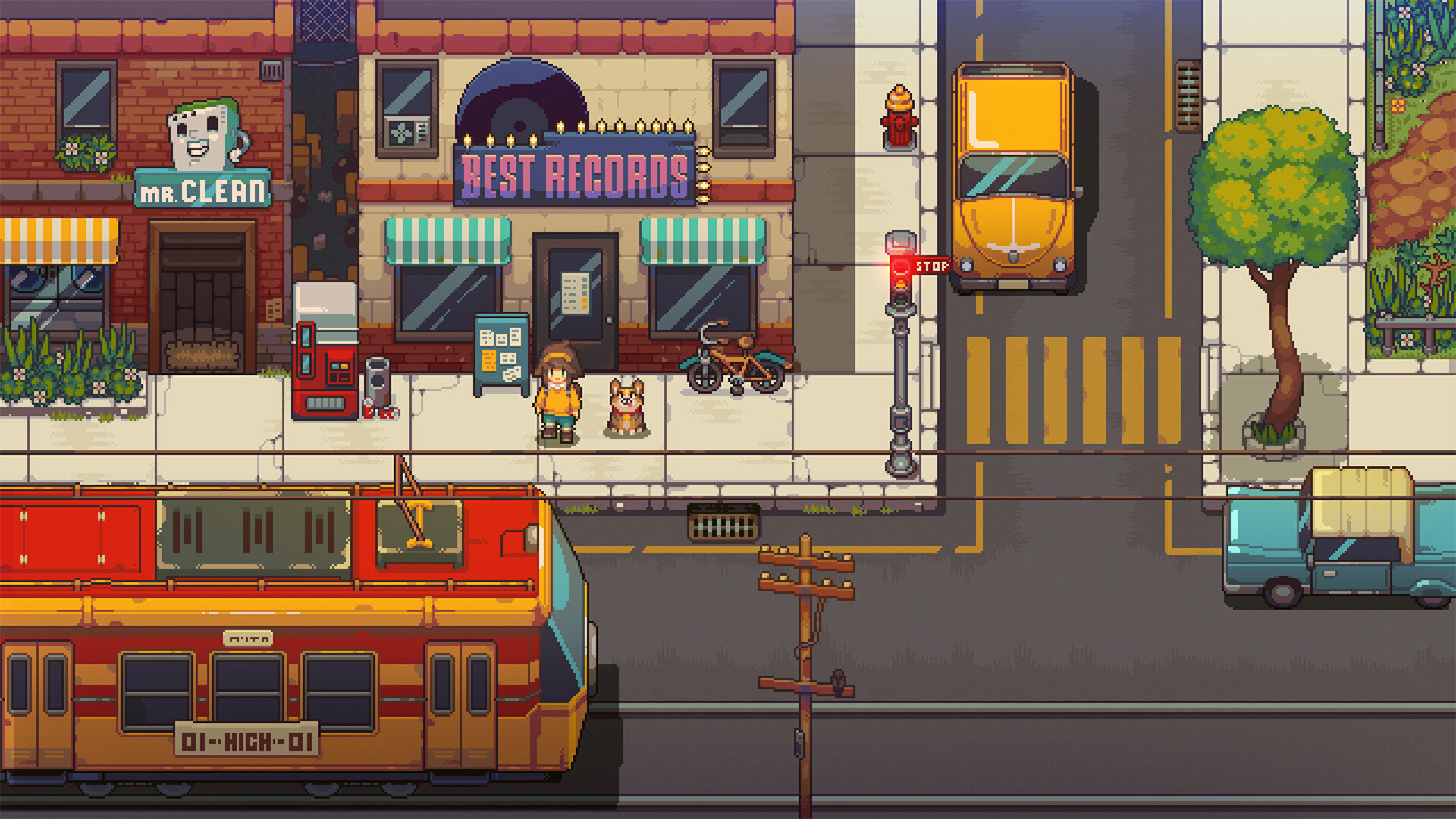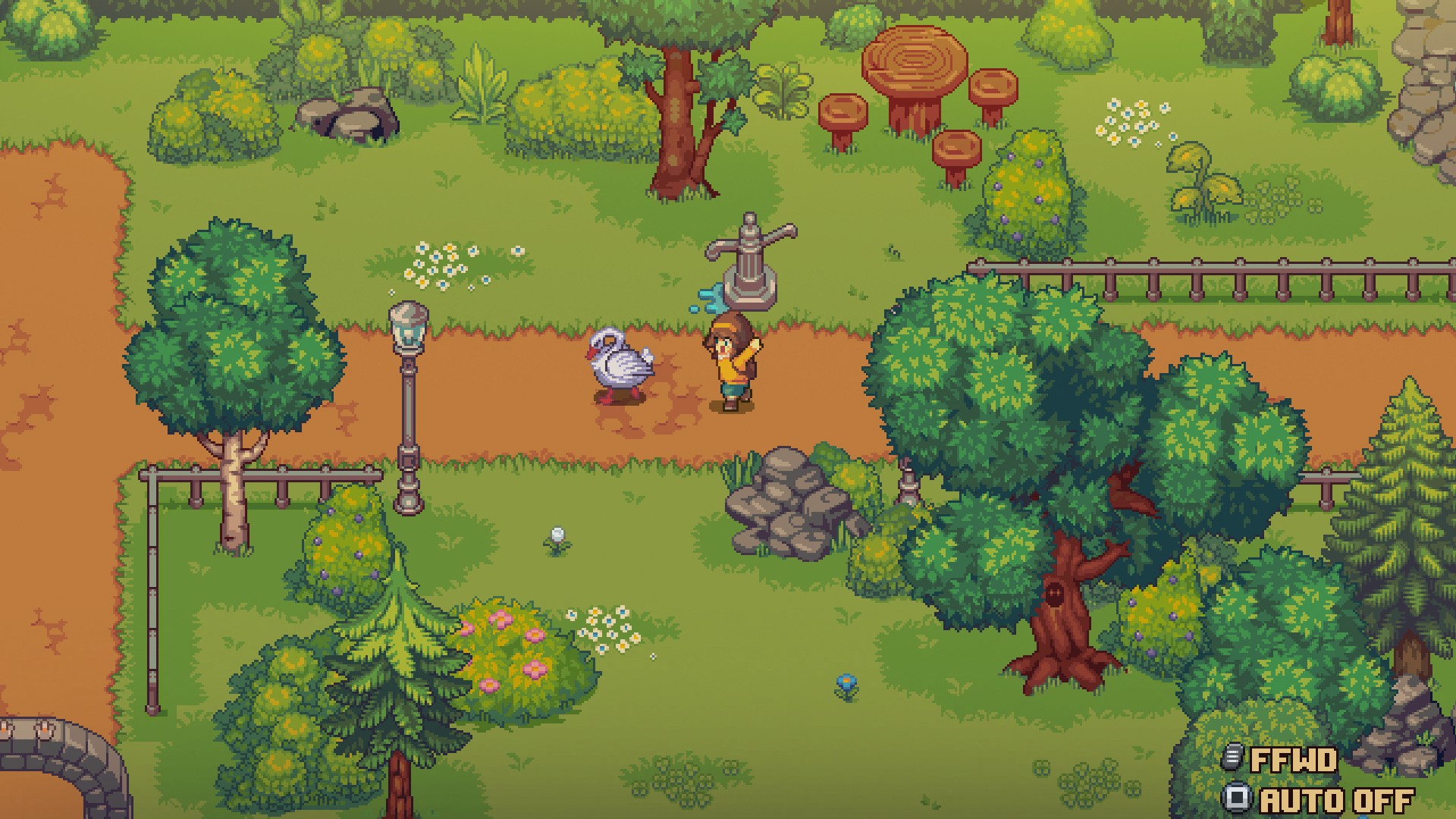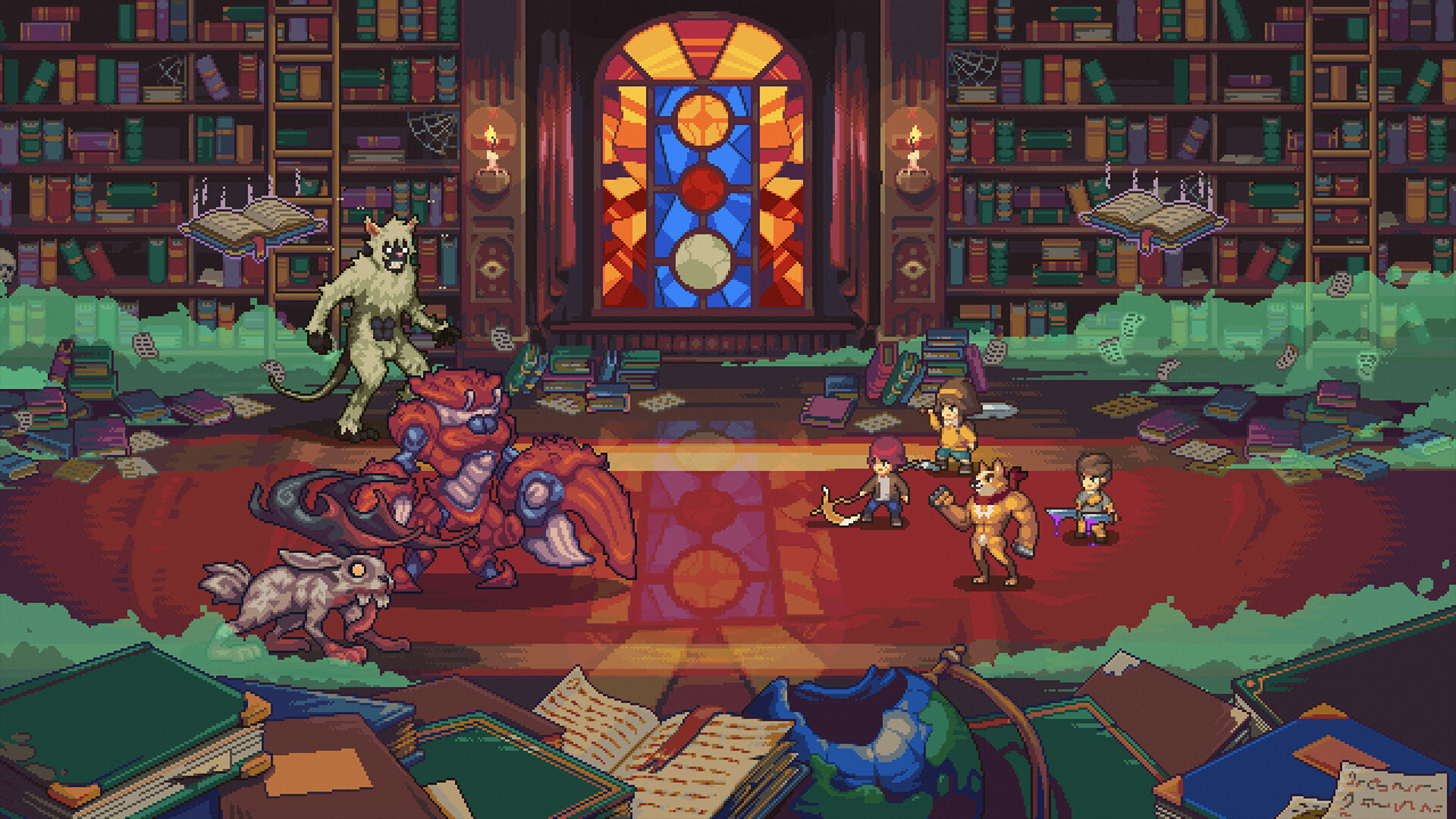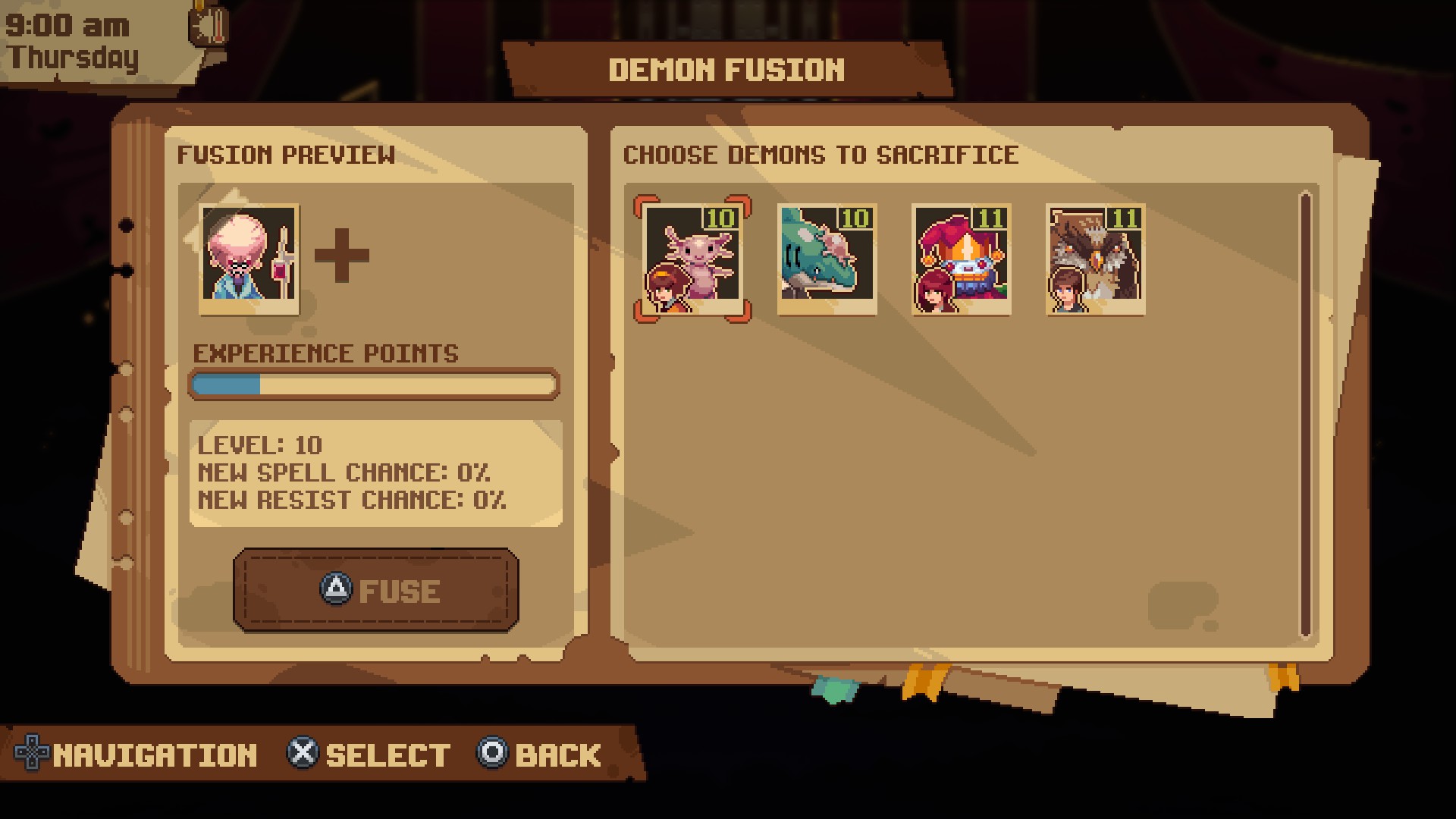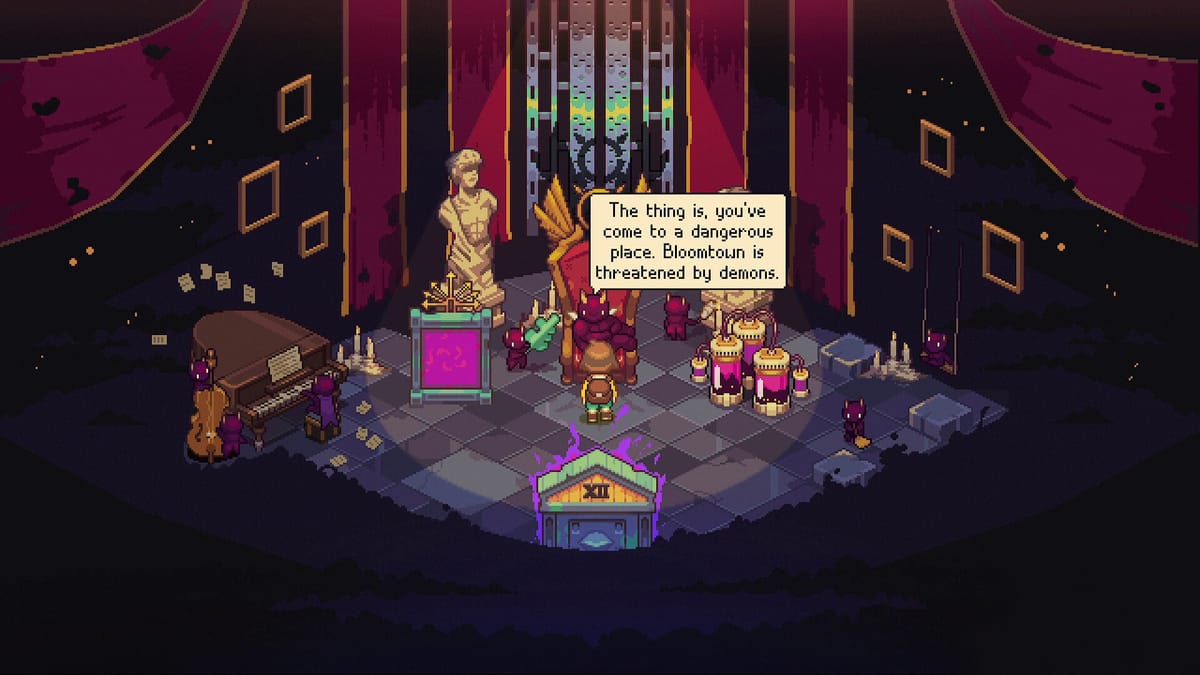
Cozy and pure is the impression you get when you initially think of the setting of Bloomtown, it’s the start of summer in the 1960s, and our child protagonists Emily and Chester have just been shipped out to Grandpa’s where the adventure of childhood is awaiting. This is a time before technology and the internet kept kids inside all the time (not preaching, it’s literally me), when kids sought adventure with mud on their knees and stick in hand, staying out till the sun sets. However, Lazy Bear Games quickly snuffs out this dream-like vision as you realize Grandpa isn’t exactly welcoming and children are going missing from the streets.
This studio is no stranger to spooks and mystery. Their previous game, Graveyard Keeper was a spin on the farming sim where you harvested bodies and talked to skulls. However, alongside this were bursts of quirky humor and satire to keep things light-hearted. This seems to be a studio signature as Bloomtown: A Different Story follows in its tracks, blending quite heavy themes with the humor of child-like ignorance and even more satire, culminating in a rich yet entertaining experience.
The mystery of the children’s disappearances is quickly answered when Emily is approached by Lucifer in a dream sequence. He persuades her to sign a contract where she gains the use of a demon who will act as a partner who fights her battles. In exchange she defeats the three demons that threaten Lucifer, which are conveniently linked to the childrens’ disappearance, thus entangling Emily in Bloomtown’s secrets. And if she doesn’t defeat them by the end of the summer? Her soul is forfeit, how lovely.
Through this, she discovers the Underside, demon-infested spaces that parallel the real world and act as the game’s main dungeons. These were really cool spaces that got better as the game progressed. The game begins with a lackluster first level with minimal puzzles and a lot of empty rooms, but served as more of a taste-tester for the game and didn’t drag on more than necessary. The second boasted more interesting puzzles with cool side-quests that kept you changing from Underside to Bloomtown with an intense conclusion, whilst the third stood out with interesting gameplay mechanics including a role-swapping system and a bustling landscape populated with shadows. Overall, paired with story beats that raised stakes and revealed disturbing details, the dungeons were fun, varied, and well-paced.
Both Underside and Bloomtown are pictured through stunning pixel-style visuals that I honestly never get tired of in modern games, but don’t fall into looking like others in the genre. The visuals are wholly unique and perfectly capture the vibes the team is trying to convey. I especially want to draw attention to the background art for the Underside battles and the demons themselves are so flashy and memorable that I couldn’t wait to see new appearances. I never saw a demon and thought, “yep I’ve seen that before”. Everything was refreshingly new, from veiny-brained vampires with blood IV drips to frogs with marching band costumes. Battles also have vibrant backdrops that add a level of atmosphere to the dungeon you’re in, especially the eerie moon in the sky in the forest dungeon.
This sense of style doesn’t only include the visuals but also stretches to the soundtrack. In extremely Persona-esque fashion, each battle theme is sung to get you pumped for the battle and it’s a welcome surprise. Each song had wormed into my head by the time the credits rolled. if you’re not vibing to its tunes, the game allows you to turn them off.
The game takes inspiration from the Persona series, which raises the question common to any art form: is it inspiration or copying? Games have been criticized for blatantly taking things from other games and putting them in their own. Breath of the Wild spawned loads of games that were similar. When staple games of their genre make waves, it’s obvious that their features would be imitated to replicate their success. The focal question should be whether replicating elements from past games are done in a derivative way, or if they say something new or valuable. Sadly at times, I don’t think Bloomtown uses Persona’s elements to much advantage.
Outside of demon fighting the game is a life-sim, allowing the player to engage in a range of activities that either puts points into the game’s skill system, earns you money, or raises friendships in its confidant system. The life-sim emphasizes skill building, including proficiency, guts, charisma, and smarts, which play a role in skill checks, this is represented through a dice roll. These checks match the situation: to scare a swan you need guts and to dupe a museum into buying Chester’s art you need charisma.
However, this system never truly impacted the story or choices I wanted to make, and while the dice roll system adds an element of chance and risk, your skills are raised quickly so you’re able to pass most checks with ease. If you fail a check the outcome is quite black and white, it either has no consequence, or you’re completely blocked from a quest. This imbalance and lack of impact never made me think of this system in a meaningful way and didn’t entice me to manage my time and what activities I chose to do.
You can also build friendship with your party members, Chester, Ramona, and Hugo, as well as an additional character. Each character has events that tell you more about themselves and the problems they have, whether that be family or mortality. Each event also unlocks a new ability that helps in battle which is a nice bonus. This system replicates the confidants and social links of the Persona series. Bloomtown succeeds in bringing a nice depth and comedic relief to each character that is enough for a 20-hour game.
My only complaint is that the character’ depth isn’t explored through the narrative. Since the characters join early and quickly, there’s no easing into what they represent in the group or how they contribute to the story. Each character lacks an impact in the narrative, so I wasn’t wholeheartedly behind their grand adventure. They start the game the same way they end it, with only their social links to characterize them.
The other side of gameplay is its turn-based battle system. I finished Bloomtown satisfied by its combat. The battles play out like Persona and its enemy weakness system. For example, you expose a weakness of wind with wind magic. Simple and easy to grasp. However, Bloomtown layers its combat with unique features such as enemies in the back of the formation not being able to be hit with melee attacks. This added an extra layer of strategy alongside the combos you could execute if an enemy was inflicted by a status condition. If an enemy is burned, you can use another magic spell to deal extra combo damage, a satisfying oomph that makes battles less of a slog. However, one qualm I have was the early game hit rates. The game gives you no indication of how likely you are to hit an enemy apart from a spell saying it has a high or medium chance of hitting. However, I found my party members missing too many times to be reasonable.
Bloomtown pairs its combat system with a demon-collecting element of the game. Every enemy you encounter (except bosses or ‘elite’ type enemies as they have no weaknesses) can be captured to add to your team. If you exploit their weakness, they become downed and ripe for the capture. You then proceed to spin a die to see if you can execute the capture. Simple and addicting stuff, as most of the time demons are easily captured and a later-game ability makes the dice roll redundant. Once added to your roster, each party member can use one alongside the main demon that is naturally given to them when they join the party.
However, I found the usage of the demons quite underwhelming. You can fuse demons to create more powerful ones, you just pick who you want to be stronger and start dumping the low levels in. I rarely used this function due to its lack of use in gameplay and the lack of reward for doing so. If you decide to fuse, it takes around 3-4 demons to gain a level up and a 30% chance to learn a new spell. This percentage rises as you put another load of demons in, but reflects that the player must grind to have a lot of demons to pour into your main, an option I didn’t want to engage with.
Simply leveling up your main is enough in the dungeons, as I never encountered any real difficulty in its battles. You simply exploited enemy weaknesses and combo for damage. The game would have benefited from a compendium to show off their stellar demon designs and to track your progress to know what you’ve caught and haven’t caught. This feature always pairs well in catch-em-style games, so it’s something I’d love to see!
My review copy also suffered some other minor issues that could easily be patched, so I won’t dwell on it for too long. The game often had grammatical and spelling errors. Quests and side-quests alike cluttered the screen with excessive pop-ups. This system could be refined to instead alert the player of a main task and then have a list underneath the task to check off in the menu. The game could also benefit from character names being displayed as they speak, as often it’s hard to tell who’s saying what. However, in the grand scheme of things, these issues should not overcast what Bloomtown has to offer.
Bloomtown: A Different Story
Good
Overall, Bloomtown: A Different Story is like a carefree summer vacation. It’s a fun ride with its quirky characters, cozy blended with spooky vibes, and some thoughtful moments that have the foundation for a great game. The gorgeous visuals paint the world beautifully and its demons are original and striking to see in battle. However, this game lacks the depth and voice to stand out in its genre, especially with how closely it uses Persona as an inspiration.
Pros
- Vibrant pixel-style visuals with a special mention for the demons!
- Varying dungeons that get better as the game progresses
- Friendship events are fun and in-depth
Cons
- Lackluster demon-collection and fusion system
- Lack of characterization and impact in the narrative
- Errors in speech and need for polished UI

